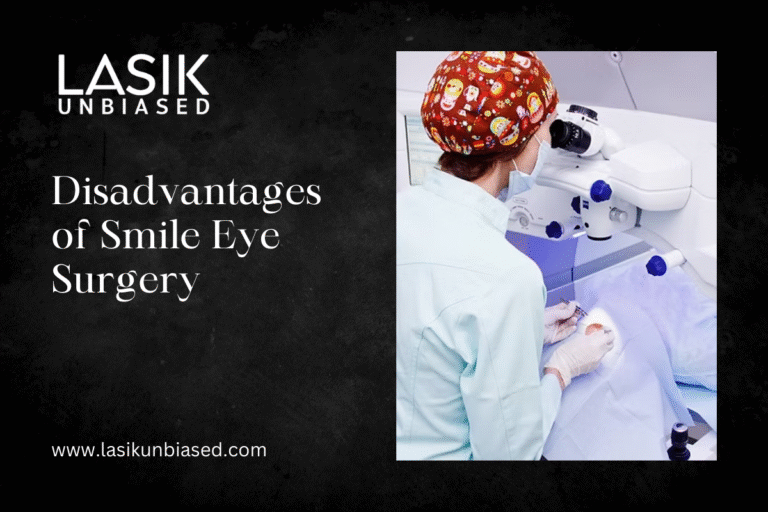SMILE is a minimally invasive laser surgery primarily for myopia and mild astigmatism, but it has limitations, like slower visual recovery and fewer trained surgeons.
Understanding these drawbacks helps patients make informed decisions.
Limited Range of Prescription Treatment
SMILE is not currently utilised to correct hyperopia (farsightedness) in the majority of clinics.
One of the most well-known disadvantages of the SMILE procedure is its limited eligibility criteria. SMILE (Small Incision Lenticule Extraction) is FDA-approved for correcting myopia and mild to moderate astigmatism, but it is not suitable for hyperopic prescriptions in many parts of the world. If you are farsighted, this procedure may not yet be an option unless you’re eligible for the advanced version, SMILE Pro, which has expanded indications, including up to +7D hyperopia correction.
This limitation means patients with certain refractive errors may need to consider alternatives like SMILE Pro, LASIK, or PRK.
Fewer Trained Surgeons and Clinics Offering SMILE
The adoption of SMILE is still expanding, but it’s not as widely available as LASIK.
Although over 10 million eyes have been successfully treated with SMILE, it remains a newer technique compared to LASIK and PRK. Many clinics have not yet invested in the expensive ZEISS VisuMax system required to perform this procedure. As a result, patients might face difficulties finding an experienced surgeon or a clinic offering SMILE, especially in regions where access to cutting-edge technology is limited.
Surgeon experience also plays a significant role in outcomes. Because fewer ophthalmologists are trained in SMILE compared to LASIK, patients may need to travel or wait for treatment, reducing convenience and accessibility.
Higher Equipment Costs Result in Higher Treatment Prices
State-of-the-art technology comes at a cost.
The VisuMax 500 and VisuMax 800 from ZEISS are advanced laser systems required for performing SMILE and SMILE Pro, respectively. These machines represent a significant financial investment for clinics, which is often reflected in the higher cost of surgery for patients. While many find the results worth the price, it can still be a barrier for some individuals.
Visual Recovery May Be Slower Than LASIK
Patients may take slightly longer to reach optimal visual clarity.
With SMILE, laser treatment time is approximately 22 seconds per eye, and visual recovery generally occurs within 3 to 4 days. While that’s fast, LASIK typically provides sharper vision within 24 to 48 hours. SMILE patients may experience mild blurriness or visual fluctuations during the early recovery period.
Although these effects are usually temporary, this could impact activities such as night driving or screen work immediately post-surgery. Patients who seek immediate, crystal-clear vision might find LASIK or SMILE Pro to be more suitable in this regard.
Challenges in Performing Enhancements or Retreatments
Enhancing residual refractive errors after SMILE can be more complex compared to LASIK.
Although SMILE boasts high accuracy and patient satisfaction, a small percentage may experience undercorrection or overcorrection. If this occurs, enhancement procedures may be required. Unlike LASIK, where the surgeon can lift the corneal flap to perform a quick retreatment, SMILE involves a flapless approach, making enhancements more complicated.
Often, surgeons may resort to surface ablation techniques like PRK for enhancements, which come with longer recovery times and increased discomfort compared to a LASIK-style enhancement. Some surgeons may also perform a CIRCLE procedure, which converts the SMILE cap into a LASIK-style flap to enable traditional LASIK enhancements; however, this technique is technically demanding and not widely practised.
Potential Side Effects – Though Rare – Still Exist
Minimally invasive doesn’t mean zero risks.
SMILE is known for preserving more corneal integrity than LASIK because it does not involve creating a large flap. This often results in fewer complications, especially related to corneal nerves and dry eye syndrome. However, as with all surgical interventions, some side effects may still occur, including:
- Temporary dry eyes (though typically less severe than with LASIK)
- Visual disturbances like glare or halos in low light
- Ocular discomfort or pain
- Incomplete correction of vision
While rare, more serious issues like corneal disorders or retinal complications have been reported in a minority of cases. This makes thorough pre-surgical screening and post-operative care critical to minimise risk.
Dry Eye Syndrome: Reduced but Still Possible
Dryness is less common than LASIK, but not eliminated.
One of SMILE’s advantages is that it generally results in less dry eye post-surgery because it avoids cutting the corneal nerves as extensively as LASIK. However, some patients still report temporary dry, gritty, or scratchy sensations after surgery. Fortunately, these symptoms are often mild and can be managed with lubricating drops.
If you have a history of chronic dry eyes, your ophthalmologist might still recommend alternative treatments or pre-treatment management before proceeding with SMILE.
Not Ideal for Every Eye Shape or Condition
Certain corneal shapes or thicknesses may disqualify patients.
Though SMILE preserves corneal strength better than flap-based procedures, it’s not suitable for everyone. People with irregular corneal topographies or other eye health issues may not be good candidates for the procedure. Comprehensive eye scans and diagnostic tests are necessary to assess suitability.
SMILE Pro: The Next Evolution of Lenticule Extraction
Overcoming current limitations with advanced technology.
To address some of these disadvantages, ZEISS introduced SMILE Pro, the latest and most advanced version of SMILE. This upgraded procedure is performed with the ZEISS VisuMax 800, which features:
- Laser treatment time under 10 seconds per eye
- Expanded treatment range up to +7D for hyperopia
- Smart computer-assisted systems for better alignment and centration
- Improved cut speeds and shorter suction time, reducing patient stress
SMILE Pro is designed to offer faster recovery, more precise treatments, and enhanced patient comfort. For individuals previously ineligible for SMILE due to prescription limitations, this new technology opens new doors.
Final Thoughts: Understanding the Disadvantages Helps You Decide Wisely
SMILE eye surgery offers several unique advantages — minimally invasive technique, faster healing of corneal tissue, reduced dry eye symptoms, and long-term visual stability. However, it’s equally important to be aware of the limitations and potential downsides:
- Not ideal for farsightedness (unless using SMILE Pro)
- Fewer experienced surgeons and clinics
- Visual recovery may take longer
- Enhancements are more complex
- Cost is generally higher
That said, ongoing advancements like SMILE Pro are rapidly addressing these concerns, making the procedure more accessible, precise, and effective. If you are considering vision correction, have a detailed conversation with your ophthalmologist to determine if SMILE or SMILE Pro is the best fit for your visual needs.
Being informed empowers you to make a confident decision about your eye health and future vision.


